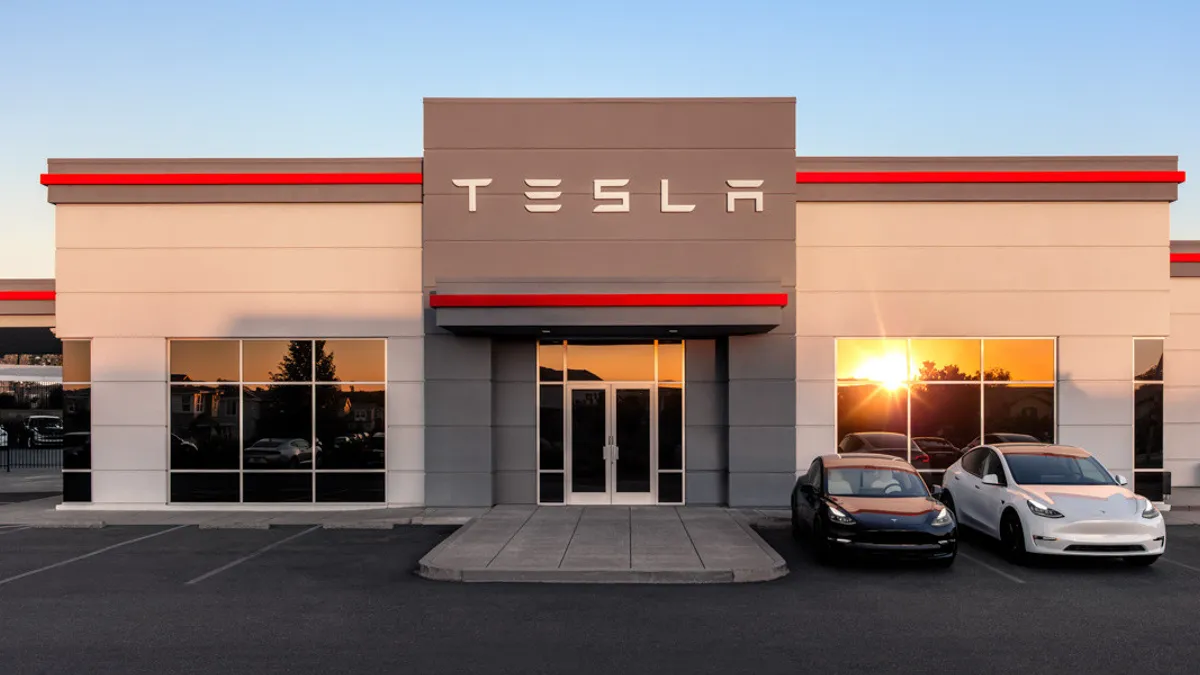Dive Brief:
- Tesla deployed 3,889 MWh of energy storage in the first quarter, up 360% over the same period last year, the company announced Tuesday. The electric vehicle maker posted a 24% first quarter overall drop in profit on EV price cuts and weakening demand.
- Storage revenue increased 148% in the January-through-March period compared with the first quarter last year, to $1.53 billion.
- First-quarter solar deployment was up 40% year over year, to 67 MW. It declined from the fourth quarter of 2022 due predominantly to volatile weather and other factors including supply chain problems affecting the solar industry, Tesla said.
Dive Insight:
The company credited the increase in storage deployments to rapidly growing energy storage production capacity at its megafactory in Lathrop, California, where it makes the Megapack battery energy storage systems. It announced on April 9 plans to build a megafactory in Shanghai to make 10,000 Megapacks a year.
In a conference call dominated by discussion of another round of EV price cuts and uncertain economic conditions, CEO Elon Musk said the January-through-March period was “by far the strongest quarter ever” for storage. He cited the ramp-up at the Lathrop plant.
“As we've expected, the stationary storage growth actually will significantly exceed the vehicle growth,” he said.
CFO Zach Kirkhorn said Tesla’s storage business is “starting to take shape” following many years of “investment and focus.”
“This business is growing as a percentage of . . . the company's revenue and reached its highest level yet in Q1, driven by an increasing rate of deliveries for our Megapack products,” he said.
Energy generation and storage revenue of $1.53 billion in the first quarter was about 6.6% of Tesla’s revenue of $23.3 billion. Automotive revenue was about $20 billion.
The company said its 40 GWh Megapack factory in Lathrop has more room to reach full capacity and “will be the first of many.” Construction on a second 40 GWh megafactory in Shanghai is set to begin later this year.
Musk said he believes that by one measure, Tesla Energy, the company’s clean energy division that makes and sells solar energy generation systems, battery storage and other products, will eventually be larger than its auto business.
“So it’s possible automotive revenue may be higher, but gigawatt hours I think will be probably higher with stationary storage,” he said.
To transition to a sustainable energy economy, more stationary energy storage is needed than there is mobile energy storage, Musk said. “And we are seeing growth of our stationary storage well in excess of automotive. So that is in line with expectations,” he said.
Tesla’s first-quarter revenue was up 24% from the same three months in 2022. Earnings per share of 73 cents were down 23%, on net income of $2.51 billion, down 24%, from $3.31 billion in the year-ago period.
Revenue and profit missed Wall Street estimates and Tesla’s share price fell Thursday morning, trading at $167.87, down 7%.
J.P. Morgan analyst Ryan Brinkman said in a client note that Tesla “strikes us as an automaker intent on producing as many vehicles as it is able, readily willing to trade profits for sales.”
“Rather than managing supply to be commensurate with demand at a given (relatively stable) price level, which allows it to realize predetermined profitability targets, the company seems intent instead on toggling price until demand is commensurate with supply that is rising as it ramps new factories in Germany and Texas,” he said.
Tesla has cut prices for auto models in the U.S. this year as it faces weaker demand, rising interest rates and stiffer competition. Musk told analysts that interest rate increases by the Federal Reserve to fight inflation are “equivalent to increasing the price of a car.”
“It makes the cars less affordable because people are able to buy cars as a function of what they can afford on a monthly basis,” he said.
Auto production of 440,808 in the first quarter was up 44% year-over-year, but rose a fraction of 1% from the fourth quarter of 2022 after rising 20% from the previous three months.
Clarification: We have updated the bullet points at the top of the story to provide more detail about the time periods used for comparisons.














